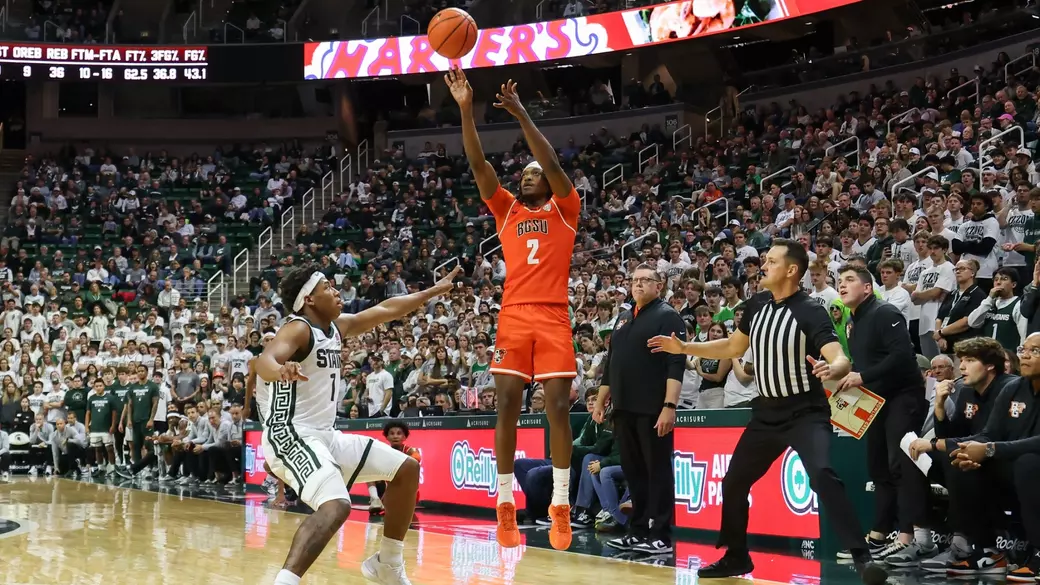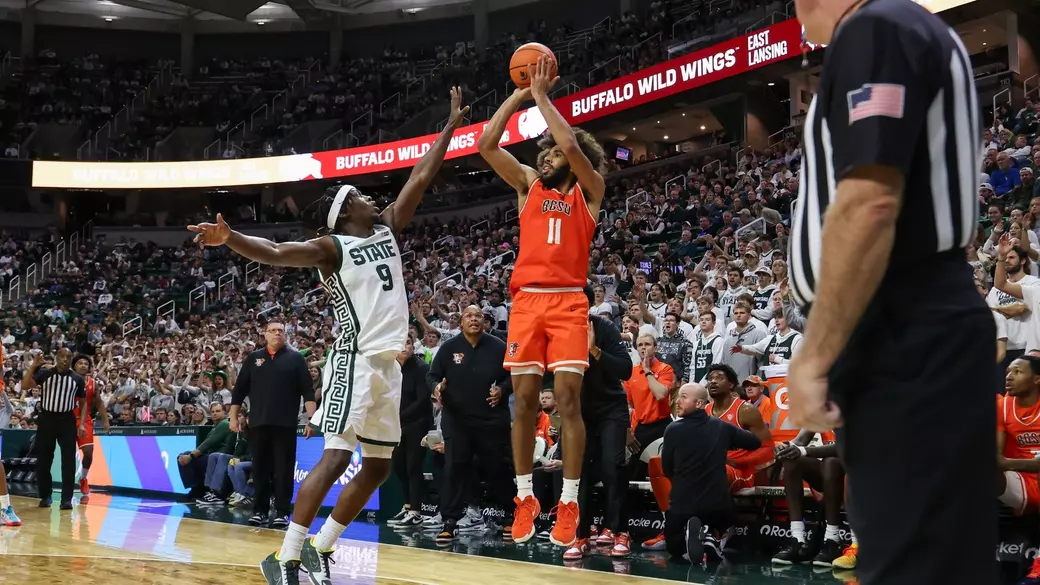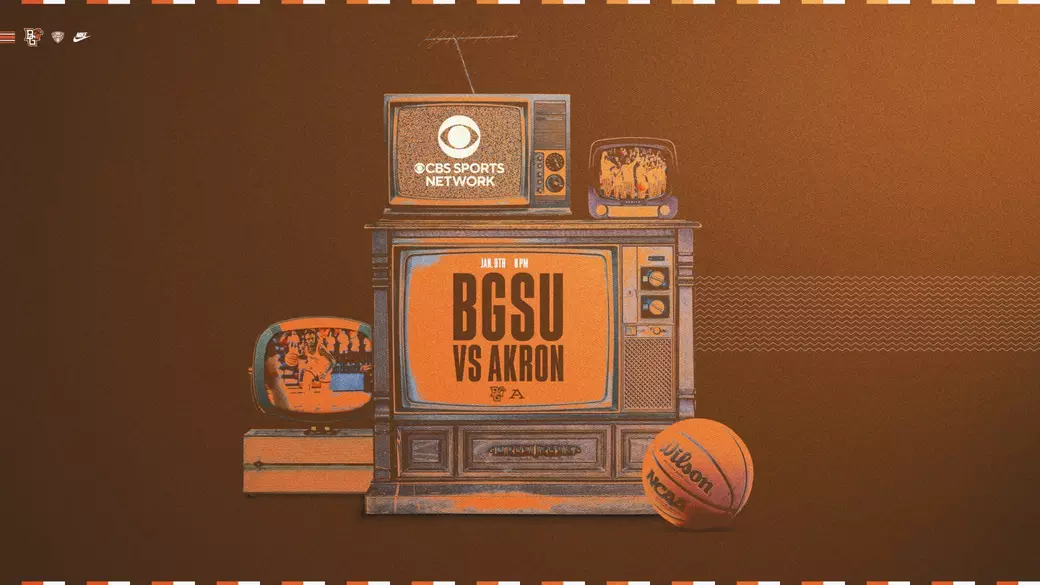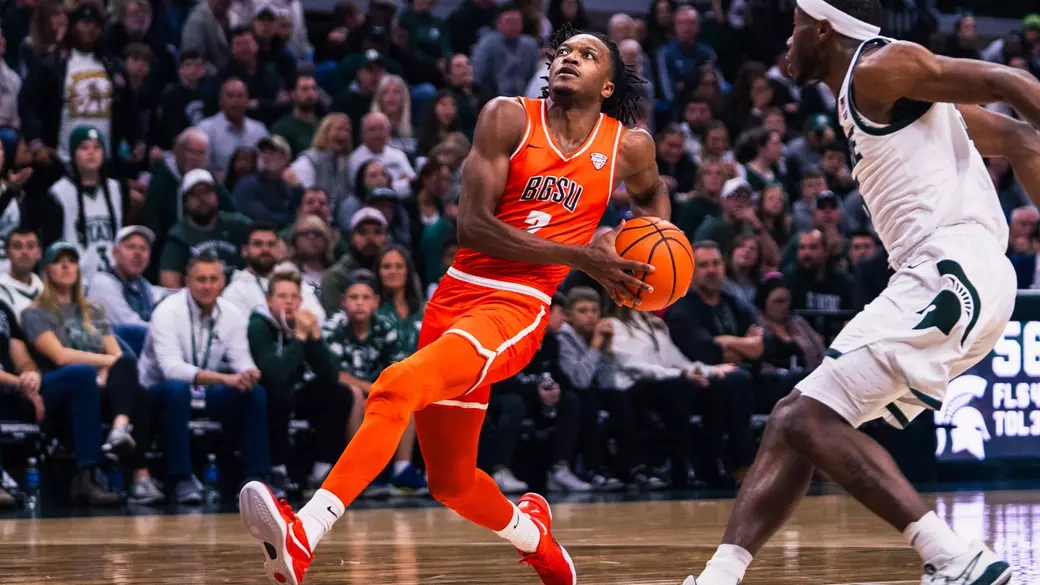BGSU Men's Basketball Begins 2024 European Tour In Germany, Czech Republic
BOWLING GREEN, Ohio - The Bowling Green State University men's basketball team is currently making their way through Central Europe as part of the team's European Tour, spanning July 31-Aug. 8. Scroll through this page, updated daily, to see how the trip is going (oldest posts at the bottom of the page).
The Falcons will be making stops over the course of the trip in Germany and the Czech Republic with cities including Munich, Nuremberg and Prague. A layover in Paris on the return trip home will also place BGSU right in the middle of the Olympics, albeit from an airport. During the trip, Bowling Green will play two games, facing TSV Oberhaching on Aug. 3 in Munich and SRSNI PISEK on Aug. 6 in Pisek, Czechia.
Day 8, August 7 - One Final Day In EuropeThe final day in Europe for the Falcons began with breakfast in the hotel before loading up the bus for a trip to the Prague Castle. Along the way, one of the guides on the trip provided background information and history on both the city of Prague and the castle. It was explained how on Nov. 25, 1989, following a series of demonstrations, the country broke free from communism with what became known as the Velvet Revolution with an estimated 500,000 protesters. The non-violent transition of power resulted in the first president of Czechoslovakia, Vaclav Havel, later becoming the first president of the Czech Republic as well. Havel had been imprisoned for being a writer, authoring plays, essays and memoirs, and appeared during the protest for the first time in decades.
The team then arrived at their destination, the Prague Castle, which is the largest castle complex in the world. Founded in the ninth century, the castle has housed Bohemian kings and Czech presidents for more than a thousand years. The tour began in the Royal Gardens of the castle, which were founded in 1534 by Ferdinand I. Habsburg and were created on the site of old medieval vineyards.
The group continued toward the cathedral within the castle walls. In 1344, Charles IV began the construction, but it was paused in 1419 due to the Hussite Wars. Additions and changes to the structure continued until it was finally consecrated in 1929. Even today, the cathedral continues to be under construction. Despite the ever-changing appearance, it has been the home to coronations of Czech kings and queens, is the burial place of several patron saints, sovereigns, noblemen and archbishops and regularly holds religious services.
After seeing the cathedral, the group dispersed for the day, enjoying a final day in Europe. Stops included the Charles Bridge, dating back to 1357 under Charles IV and the Wenceslas Square, the location of the Velvet Revolution.
Day 7, August 6 - From Germany to Czechia
The Falcons transitioned to the final leg of the trip, beginning with a bus ride from Nuremberg to Prague, crossing the Germany-Czech Republic border. The team stopped for about an hour and a half during the drive to allow lunch at a food court with multiple options for the team ranging from McDonald's and KFC to Thai and Chinese food. After the brief stoppage, the group was back on the road with the destination being their second game of the trip.
The Falcons arrived for their game at 3 p.m. local time for the 5 p.m. tip., taking on SRSNI Pisek, a Division I team in the Czech Republic. The two teams had a back-and-forth battle with the Falcons claiming an 87-86 victory. The full recap of the game can be found here.
The team then loaded up the bus with pizzas waiting for dinner and finished out the final two hours or so to Prague with a little bit of free time upon arrival at the final destination of the trip.
Day 6, August 5 - Exploring Nuremberg
The second day in Nuremberg began with breakfast in the hotel before heading out around 11 a.m. for the tour of the day, centering around the Nazi rally grounds. The first stop was the Kongresshalle, which was supposed to be Nazi's version of the Colosseum, but was never finished. Built with brick and covered with stone to resemble power, such as the Romans, the structure was planned to hold 50,000 people would have had the largest unsupported roof at the time. However, the project was abandoned. The Nazi Party was building it to host rallies, but the last rally was in 1938 with the war beginning in 1939, leaving the build in its unfinished state, two stories shy of the plans. The construction created 1,400 jobs for Germany during the Great Depression. Now, the building serves as the Nazi Documentation Center, which is essentially a museum but viewed in a different light as to not show support of the events that transpired.
From there, the group moved to the Zeppelin Field, which served as the host for many rallies and the backdrop to countless propaganda photos of the time. It's also sometimes known as Solders Field, which is the name U.S. military gave it when they occupied the land. The space can contain over 200,000 people and was the site of the Cathedral of Light, a main attraction from 1934 until 1938 for the Nazi Party, consisting of the display of 152 anti-aircraft searchlights pointed straight up. The 1936 Olympic Games in Berlin replicated the idea during the closing ceremony. The Zeppelin Field field now stands in a rough condition as arguments continue over what to do with the space, as they do for many notable Nazi locations. While many want to preserve the history as a reminder of the acts they are responsible for, others don't want to put money towards anything previously connected to the Nazi Party.
In addition to the two structures viewed, the area is still the host to many things that predate the Nazi activity of the area. FC Nuremberg's stadium is nearby and visible from both the Zepplin Field and the Kongresshalle. There is also a fairgrounds right next to the Kongresshalle that still hosts multiple events annually. As these spaces have stood longer than the Nazi Party's history, they remain in the same locations, unaltered by the history of the area.
After the tour of the two spaces, the team returned to the hotel for free time the rest of the evening, providing one last chance to explore Nuremberg before heading to Prague the next day.
Day 5, August 4 - From Bavaria to Franconia
The Falcons transitioned to the second portion of their trip, moving on to Nuremberg, meaning the rocky hill as the castle is built into a rocky hill. While Nuremberg is now considered part of Bavaria, this wasn't the case for a long time. The region was formally independent until 1806 as Franconia, so what the group saw of White and Blue flags for Bavaria in Munich changed to Red and White flags for Franconia in Nuremberg. Traveling to the city in the morning, the group arrived around noon and broke for lunch before beginning a tour of Old Town, which was a short walk from the hotel. The meeting point for the tour was the main train station. With construction beginning in 1831, the station served as the home of the maiden voyage of Germany's first train in 1835.
Old Town fits well for Nuremberg's center as the start can be traced back to 1040 under Heinrich III during Medieval times. Old Town is enclosed by a wall that was finished in 1470, including a moat around the roughly 5-6 kilometer perimeter. In addition to the wall and moat, five towers stand as entrances to the Old Town that provided additional protection to the city. The protection caused the Kaiser to favor Nuremberg for safety as well as trade routes. During this time, Nuremberg was viewed as the Imperial Treasure Chest during the Holy Roman Empire and flourished until the Thirty Years' War that began in 1618.
The city again rose to high importance when the Nazi Party came into power. Hitler enjoyed the city and made it the home for many of the Nazi Party rallies. This made it a target during World War II. On January 2, 1945 the Royal Air Force dropped 6,000 bombs on the city, destroying most of the structures within. Now, majority have been either fully rebuilt in the original image or pieced back together from the debris left behind. Despite the high number of bombs, less than 2,000 people were killed in the bombing due to an extensive underground storage system from the Medieval times that served as a bomb shelter for the city. The system is four or five stories tall with six different tunnel systems and had previously been built for beer storage over 500 years prior.
One of the main landmarks the group saw was a church located near the entrance. The church was fairly unharmed during the bombings with only the back end and roof being damaged. The front doors and steeples are still original. The church, along many others in the region, had one distinct difference than the ones in Munich. They were Protestant. While Munich is a heavily Catholic community, Nuremberg was impacted differently. During Martin Luther and the Reformation, this church, along with many others, flipped from Catholic to Protestant nearly overnight. Now, there are just two Catholic churches in Nuremberg.
The group then moved on to the town center in Old Town. Old Town is split into two districts that are divided by the Pegnitz River with the river having the most bridges in Europe. However, in the 1500s they wanted to unite the districts. To do so, Charles IV agreed to build the square and gave a location. The location, however, has a dark history. A Jewish community at the time, over 500 people were killed on Dec. 5, 1538 and a synagogue burned down to make room for the square.
The final stop on the tour was a trip uphill. Very uphill. The castle provided the view for the trek as the Falcons climbed the roads to the Imperial Castle of Nuremberg at the top of the hill. The climb provided picturesque views and completed the trip from the south end of the Old Town wall to the north end. From there, the group dispersed on their own, including one group running into a two-time BGSU graduate who has now relocated to Germany.
Day 4, August 3 - An Emotional Morning and Active Evening
The final full day in Munich was a full schedule for the Falcons. After breakfast in the hotel, the group loaded the bus and traveled to Dachau, the first Nazi concentration camp during World War II, beginning operation on March 22, 1933 and lasting until it was liberated by U.S. forces on April 29, 1945. The camp, anchored in forced labor, became a model for the creation of additional camps by the Nazi Party moving forward. The grounds include an audio tour with the history of each stop as well as recorded recollections from survivors and liberators of the camp.
At Dachau, the team began by viewing a documentary on the history of the grounds before being able to explore on their own. Options included the museum that illustrated a chronological history of not only the camp, but the Nazi Party during World War II, rebuilt barracks, the original crematorium and various memorials that have been added throughout. While the original 34 barracks were torn down in the 1960s, two replicas now stand as a reminder of what was there. In total, the grounds cover five acres and provide a very moving experience. (Out of respect, no photos from Dachau are included in the photo gallery).
Once the tour was finished at Dachau, the team loaded the bus to head back to the hotel to begin pre-game prep. To lighten the mood after a tough emotional morning, the team sang Happy Birthday to head coach Todd Simon on the way back to the hotel. After a brief moment in the hotel, the team walked to a nearby Italian restaurant for their pre-game meal and then back to the hotel to load the bus and head to the game.
Arriving in a far smaller gymnasium than the Falcons are used to playing in, BGSU took on TSV Oberhaching in front of a packed house. Wall-to-wall fans inside the gym made for a loud and intense environment from the jump. Open double-doors on one end provided a cool temperature inside and the aroma of the grill for the concessions pulled in the doors from time to time throughout the game. Using various rotations and groups, Bowling Green was able to capture an 80-69 victory in the first game of the trip, a nice birthday present for Coach Simon. Following the game, the teams visited with each other and the fans while enjoying a few celebratory bratwurst from the grill that filled the air during the contest. Full game recap can be found here.
After the game, the team returned back to the hotel for one last free night in Munich to close out the first portion of the trip with travel to Nuremberg looming in the morning.
Day 3, August 2 - BG Turns FC
The first day with a night's sleep to back it up, the second day in Munich proved to be a sport-centric one for the Falcons. The group woke up and had a breakfast buffet in the hotel before starting out for the day. The first stop? Allianz Arena, home of FC Bayern and the second largest stadium in Germany. The stadium also hosted an NFL game in 2022 between the Tampa Bay Buccaneers and the Seattle Seahawks and will do so again in the 2024 season, this time featuring the Carolina Panthers and New York Giants on Nov. 10.
The 75,000-capacity, including 15,000 standing room only, venue finished construction in 2005, taking 30 months to build. The architects took inspiration from the Roman Coliseum, envisioning today's modern soccer stars as history's gladiators. The stadium features an exterior membrane that is inflated by air and is the largest of its kind in the world. Originally, the stadium was built in neutral tones, housing two teams, but now FC Bayern is the lone occupant and has customized the venue, complete with a red-chaired second deck, a logo on one end, the team's name on one side and the team's motto "Mia San Mia" (We Are We) on the opposite side.
Within the stadium, there are 106 sky boxes that require a five-year minimum purchase and allow box owners 365-day access, with the exception of overnight stays. The waiting list for such boxes extends until 2050. Another stadium feature includes the third-largest video boards, which used to be two before Real Madrid's 360-degree video boards were added. There is also a section of the venue blocked off for visiting fans, including their own entrance, to avoid any fights before, during or after fixtures.
Following the tour of the stadium, the team transitioned to the museum and then to the team store where a few players snagged custom jerseys of FC Bayern to take home. For lunch, the team returned to same spot as the day before for lunch and free time that stretched through the evening.
Day 2, August 1 - Welcome to Bavaria
With no time for resting and jet lag to remove, the first order of business on the trip itinerary took the Falcons straight from the airport to the heart of Munich, beginning with a two-hour walking tour around 10 a.m. The group met up with their guide for the day, Ozzie. Ozzie started with a quick history lesson on the area. While geography may say the group was in Germany, the locals will say the group was in Bavaria. In fact, hanging a German flag in Munich is illegal. Without a German flag in view, only the White and Blue Bavarian flag, the culture of the area reflects the 1918 stance that separated the area from monarchy. Following World War I and the Treaty of Versailles, the 1918 stance of the area was that of a "Free State of Bavaria." The only thing keeping Bavaria from being a country on their own now, according to the United Nations qualifications, is a central bank. Additionally, the name Munich comes from the origin of the city, which can be traced back to Monks, making Munich one of the most religious cities in the area. As Ozzie put it, they center around Pork, Beer and Jesus.
The group proceeded to see two buildings that house the only three towers that survived the American bombs of World War II, a series of acts that destroyed more than 90% of Munich. Since then, the city has been rebuilt to resemble what it once was, but with more modern features like air conditioning and elevators.
One of the buildings is the Frauenkirche, or the Church of Our Dear Lady, housing two of the three towers. Construction began in 1468 and continued until 1525. Due to the slow build, the story says that the builder made a deal with the Devil to finish the building quicker, agreeing to not place any windows. Although the cathedral does have windows, there are footprints left by the Devil inside. When standing on top of the footsteps after construction, not a window was visible due to pillars. Now, a single window is visible straight ahead from the location due to renovations over time on the structure. On a lighter note, the cathedral, and Munich as a whole, played the backdrop to the 1971 film "Willy Wonka and the Chocolate Factory."
In addition to the architecture of the area, the group was filled in on a list of history that pairs with the area. Munich has been the birthplace and home of many things, including but not limited to Oktoberfest, the largest train station in Europe, the Illuminati and the birth of the Nazi party. The group also stepped inside the Hofbrauhaus location that Adolf Hitler made his first speech. The Nazi symbols on the ceiling above the light fixtures have since been painted over with pinwheels reflecting the colors of Munich and Bavaria.
Near the conclusion of the tour, the group moved to the highest point in Munich, which was really just an upward slant. Despite being in the Bavarian Alps, Munich is a rather flat city, as are most in Germany. It was at this point that the group learned of Munich's sister city, none other than Cincinnati, Ohio. In fact, Cincinnati played a large part in the reconstruction of Munich following World War II, using photos from before the war to rebuild the city in an image that was consistent with it's pre-war look.
The last part of the tour was lunch. The group stopped for bratwurst, coming in various varieties that included classic, spicy, beef, vegetarian and more. The team was also introduced to "Spezi" a combination of Coca-Cola and Fanta. During World War II Coca-Cola syrup couldn't be shipped into Munich, but the bottling company left behind could still make drinks, so they began making Fanta. Coca-Cola later acquired Fanta in 1960, after it was relaunched in 1955 with a new recipe, and the Spezi drink was born. Dessert followed with pretzels and sweets before heading to the bus and eventually hotel to wrap up the day's team activities with free time taking up the remainder of the day's schedule.
Day 1, July 31 - Traveling To Munich
A direct flight for the Falcons made it a relatively smooth start to the trip. It took almost exactly 12 hours to the minute from pulling out of the Stroh Center parking lot to wheels down in Munich, Germany (or rather Bavaria, explanation provided in Day 2 recap). The team was able to make it the terminal and on the plane with minimal bumps and set off from the Detroit Airport around 6 p.m. EST. Traveling through the night and attempting to log a bit of sleep amid in-flight movies, music and the like, the Falcons touched down in Munich around 8:10 a.m. local time (2:10 a.m. EST), beginning the next part of a long day to begin the trip.
Follow the Falcons
Be sure to follow the Falcons' men's basketball team on social media
Twitter - @BGSU_Athletics and @BGSUMBB
Instagram - 'bgfalcons' and 'bgsumhoops'
Facebook - 'BGSU Athletics'
YouTube - 'Falcon Athletics'
Latest Men's Basketball News
- Men’s Hoops To Open 2025-26 Campaign Monday Night With First Of Three Straight Home GamesBOWLING GREEN, Ohio - The Bowling Green State University men's basketball team will kickoff the 2025-26 season Monday night (Nov. 3) inside the Stroh Center, hosting Texas State for a 7 p.m. tip. The game will mark the first of three-straight home games for the Falcons to open the season, also hosting Bethany College on Nov. 6 and Le Moyne on Nov. 9. The game against Texas State will be part of the MAC-Sun Belt Challenge, now entering its third season. BGSU is 2-0 at home during the challenge and 2-2 overall. The game between the Falcons and Bobcats will be available to stream on ESPN+ with a radio feed from Todd Walker on WFRO Eagle 99.
- Falcons Wrap Up Pre-Season Against Dayton In Final ExhibitionDAYTON, Ohio - The Bowling Green State University men's basketball team concluded their preseason slate on Monday (Oct. 27) against the Dayton Flyers. The game marked the second exhibition for the Falcons after facing No. 22 Michigan State last Thursday (Oct. 23). Bowling Green took a lead into the halftime break, ahead 30-27, but the Flyers erupted in the second half to capture a 90-59 final. For the Falcons, Javon Ruffin led the way with 20 points, going a near perfect 8-of-9 from the field. Javontae Campbell added 10 points as well. Bowling Green will now shift to the regular season, opening with the first of three straight home games on Monday (Nov. 3) against Texas State at 7 p.m. inside the Stroh Center.
- Campbell, Towns Lead Way As Falcons Challenge No. 22 Michigan State In ExhibitionEAST LANSING, Mich. - The Bowling Green State University men's basketball team took on the Michigan State Spartans in an exhibition Thursday night (Oct. 23) at the Breslin Center on MSU's campus. The game marked the first action of the season for either team and proved to be a tight contest. Throughout the game, the lead changed hands five times while the score was tied six times. Despite the Falcons winning the rebounding battle, Michigan State pulled ahead for the 75-66 final. Combined with last year's regular season game, Bowling Green has now led for over 29 minutes of action inside the Breslin Center over the two games played.
- BGSU Home Game Against Akron Selected For National Television, Moved To Jan. 9BOWLING GREEN, Ohio - The Bowling Green State University men's basketball home game against Akron has been selected for national television. The Mid-American Conference announced Thursday (Oct. 23) the ESPN and CBS Sports Network television windows for the first few weeks of the men's basketball conference season. Among those selected included the BGSU-Akron game, originally scheduled Jan. 10. The game will now be moved to Jan. 9 and will be aired nationally on CBS Sports Network with an 8 p.m. tip.
- Exhibitions Against Michigan State, Dayton Mark Beginning Of 2025-26 Men’s Basketball CampaignBOWLING GREEN, Ohio - The Bowling Green State University men's basketball team will begin the 2025-26 season with a pair of exhibitions on the road. BGSU will first head north to East Lansing, Mich. to face Michigan State on Thursday (Oct. 23) with a 7 p.m. start. From there, the Falcons will migrate south to go against the Dayton Flyers on Monday (Oct. 27) with another 7 p.m. tip. The game between BGSU and MSU will be broadcast on BIG+, but the game against Dayton will not have a video stream.
- Javontae Campbell Earns Preseason All-MAC NodCLEVELAND, Ohio - The Mid-American Conference released the preseason coaches polls for the 2025-26 men's basketball season Tuesday morning (Oct. 21). For individual awards, senior guard Javontae Campbell was selected to the Preseason First Team All-MAC. As for the team, the Falcons were picked to finish seventh in the MAC in the 13-team field following the addition of UMass this season.













